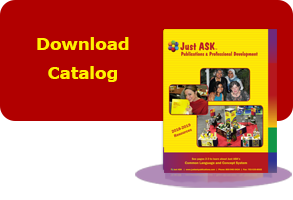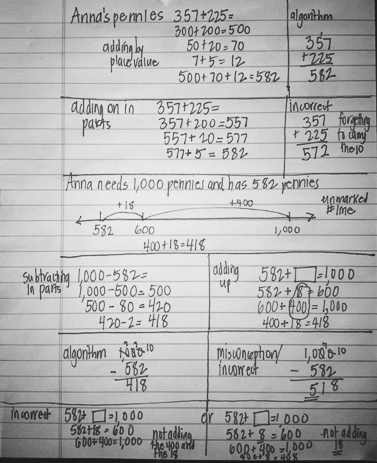
Volume III, Issue IV
|
Heather Clayton, the author of Making the Standards Come Alive!, is the principal of Mendon Center Elementary School in Pittsford Central School District, New York. She is also a co-author of Creating a Culture for Learning published by Just ASK. |
Keys to Productive Discussions
in the Math Classroom
and is as essential to all true conversation.
– Chinese Proverb
A challenge faced by math educators of all levels is how to engage students in their mathematical content through rich discussion or discourse. In classrooms where there is high-quality mathematical discourse, teachers and students ask challenging and thought-provoking questions, and there is skillful facilitation of meaningful discussions focused on the mathematics. The discussions emphasize reasoning, proof, evaluation, and justification. Students learn from one another and value the thinking of their peers. The focus of the conversation is not simply the answer to the problem, but also the students’ strategies, discoveries, conjectures, and reasoning.
The third Standard for Mathematical Practice places a strong emphasis on meaningful discourse. In this standard, students are expected to construct viable arguments and critique the reasoning of others. Meaningful discussions in the mathematics classroom rely on purposeful instructional moves from the teacher, as well as a clear understanding of the demands that are placed on students. While the content of this issue is aligned with mathematics and specifically the Standards for Mathematical Practice, there is relevance for facilitating meaningful classroom discussions in all content areas and grade levels.
The K-12 Standards for Mathematical Practice
|
The Common Core places a strong emphasis on mathematical reasoning and deep content understanding. Creating the right conditions for these discussions and facilitating conversations that emphasize a deep study of the mathematics is a challenging task. The following keys can help teachers ensure that the discourse in their mathematics classrooms is rich and extends the learning of students. The single most important thing teachers should do to ensure the success of discussions is to ask meaningful questions and facilitate the dialogue among students. The goal in any mathematical discussion is to support the students’ in constructing viable arguments and critiquing the reasoning of others.
Keys for Preparing for the Discussion
Anticipate the strategies students might use, how they will represent their thinking, and predict students’ misconceptions.
In addition to drawing on their knowledge of mathematical content, teachers must also bring to classroom discussions an understanding of their students’ prior knowledge and experiences. Once the task has been designed, the teacher must be ready to handle the different strategies that the students will propose. One way to prepare is to draft all possible student strategies, prioritize how those will be shared with the class, and anticipate places where there may be flaws in students’ thinking or misconceptions. By making these predictions in advance of the class discussion, teachers will have a clear sense of the critical “look-fors” as the students are working and an idea of how they wish to shape the classroom discussion. Undoubtedly, students will come up with strategies that the teacher has not predicted; however, teachers will be far more prepared to make sense of these approaches to problem solving when they have thought ahead about what students might bring to the experience.
For instance, consider the following problem:
Anna is collecting pennies for a school-wide penny drive. She has 357 pennies saved in the first week and 225 pennies saved in the second week. Her goal is to donate 1,000 pennies. How many more pennies will Anna need to reach her goal?
|
Teacher’s anticipation of students’ strategies and errors, prior to the discussion |
Plan questions that will guide students in answering both how they solved a problem and why they chose the solution they used.
Preplanning thought-provoking questions will ensure a high level of intellectual engagement during the lesson. Including the context of the problems is essential when forming these questions. By asking students to use the context of the problem when determining their solutions, they are more likely to have solid reasoning for why they solved the problem in the way that they did. For instance, the teacher might ask:
- Why did you _____________ when the problem asked for _____________?
- What does _________ mean in terms of _________________ as it stated in the problem?
- Does this solution make sense given what the problem is asking?
- Why are we ______________ in this problem?
Decide which strategies should be prioritized when sharing with the whole class.
It can be overwhelming for students to hear and understand the reasoning behind too many different strategies at once. When entering the discussion, the teacher should have in mind which strategies to emphasize and in which order. For instance, if it is a problem dealing with subtraction, the teacher may choose to emphasize the use of an unmarked number line or adding up before having discussions about adding or subtracting the same number from the minuend and subtrahend in order to create an easier problem and not change the answer.
Keys for Facilitating Discussion
Establish a safe environment where students can take risks and where there are norms for classroom discussions.
In order for students to openly share their thinking and risk-making mistakes in front of their peers, it is imperative that there is a supportive classroom environment. Everyone should understand their role in the classroom through the development of classroom norms. The teacher is expected to pose thought-provoking questions, support students’ conversations, listen carefully to monitor students’ understanding and misconceptions, encourage student participation in discussions, and promote student reflection about the learning experience.
Nancy Anderson, one of the authors of the National Council of Teacher of Mathematics’ book entitled, Classroom Discussions: Using Math Talk to Help Students Learn, suggests that teachers instruct their students on the importance of and expectations for mathematical conversations at the start of the school year. She explains how talking like mathematicians can enable students to be stronger mathematical thinkers. As Anderson tells her students:
- Talking and thinking together can help all students understand math better
- It is necessary for more than one person to help solve challenging problems
- There is a great deal to be learned from listening to how other’s think
- Talking about your thinking helps you to clarify your own thoughts
- When talking about the mathematics, you practice using important math vocabulary
- You can learn a great deal about what it takes to understand the ideas of others.
Along with establishing a rationale for mathematical discussions, it is also critical to establish expectations for respectful listening. Students need to be seated where they can see and hear the speaker, and they are expected to listen actively and be prepared to respond to the ideas of others. Students are taught how to respectfully disagree and question one another. Above all, there is acceptance of all ideas and all contributions to the discussion are honored. Once the school year is under way, it is important to revisit the established norms in order to maintain the quality of conversations.
Teach students the expectations for classroom discussions.
Despite efforts to establish a rationale for discussions and expectations for listening, rich discussions in mathematics do not happen by chance. The explicit teaching of how students are expected to respond and interact during a classroom discussion in mathematics is necessary. students sharing their thinking should know that their explanations require more than just a description of the strategy they used to solve a problem. Rather, students need to include some sort of visual representation, along with an explanation of how they solved the problem and why they chose to solve the problem in that way.
Students who are listening should be attentive to the thinking of others, reflect on the ideas they have heard to evaluate their efficiency, determine if they agree or disagree, if they understand the thinking of their peers, and what similarities and differences they see between their own thinking and the thinking of others. Students need to be taught how to agree and disagree and how to ask questions for clarification. Provide students with prompts to use during discussions. For instance, students might say:
- The way ______ solved the problem makes sense to me because…
- ______’s strategy was similar to mine because…
- ______’s strategy was different than mine because…
- What I don’t understand about ______’s explanation is why _______.
- I will need to hear _______ explain how _________ again.
- Why did you _____ when you were solving this problem?
- I understand how you ______, but why did you ______?
Present meaningful problems.
Teachers should focus on assigning mathematical tasks that are appropriately challenging and enhance students’ learning. Mathematical tasks should investigate important mathematical ideas and have authentic contexts and relevance for students. The problems posed should have multiple solution strategies, encourage investigation, promote reasoning, and require students to provide justifications for their thinking. Ultimately, mathematical tasks should be worthy of student discussion and emphasize important mathematical concepts.
Build in opportunities for independent work and partner or small group work.
In order to help students summarize and understand their thinking as well as the thinking of others, it is essential to provide opportunities for students to “turn and talk” about their ideas. For instance, after presenting a problem, students may be asked to represent or state in their own words what the problem is asking, then share that with a partner. After finding an entry point and solving a problem independently, students should share their strategies with a partner or in a group, prior to sharing with the whole class. This gives students practice constructing arguments, providing justifications, and critiquing the thinking of others. Students learn how to listen in a way that prepares them to restate their partner’s thinking in their own words, as well as listening to understand and pose questions of their partner. Partnerships ensure a higher level of accountability and student engagement than is possible with only whole class discussions.
Facilitate the sharing of strategies with the whole class.
While students are engaged in discussion, it is the teacher’s role to promote students’ reasoning, ensure that multiple solutions and answers are considered, hold students accountable for sharing both how they solved a problem and why they solved it using a specific strategy, and to make sure that students are actively listening and responding to each other. Teachers can do this is through the use of meaningful questions that will support and extend students’ understanding of the reasoning of others, along with the important mathematical ideas.
The teacher should begin by collecting all students’ answers and encouraging students to think about whether or not more than one answer could be correct given the context of the problem. Then, as chosen students defend their solutions and share arguments for their strategies, the teacher ensures active listening and reflection through the use of guiding questions. For instance, the teacher might ask the student who is sharing:
- Why did you ______?
- Where did ______ come from?
- Where are the original numbers in the problem?
- How did you represent your thinking?
Questions to ask the rest of the class might be:
- Could somebody repeat what _____ has shared in their own words?
- Is _______’s reasoning reasonable? Why or why not?
- Is _______’s strategy an efficient way to solve this problem? Why or why not?
- Do you agree with ______? Why or why not?
- What do you wonder after hearing ______’s thinking?
- Can you think of a counter example? In other words, can you think of an example that would disprove an idea that has been presented?
Promote student reflection on the different strategies.
A powerful instructional move after students have heard the thinking of others is to send them back to work in partners or in small groups to reflect on the arguments of others. Carefully crafted questions such as the following can help guide these discussions:
- Which strategy have you heard is the most efficient for solving this problem? Why?
- What are some similarities you have seen between the strategies being used? What are some differences?
- What new ideas did you hear today?
- What confused you?
- What strategies do you think you could try when solving future problems?
In summary, how successfully a teacher facilitates a discussion drives how mathematically rigorous the work is for students. In order for students to be successful with constructing viable arguments and critiquing the reasonableness of answers, students need ample practice solving problems in a variety of ways and defending their thinking with others. Equally important is that students know how to listen to the thinking of others, and pose questions and counter examples as a way of deepening their mathematical understanding. The success of these small and large group discussions rests on the ability of the teacher to plan thoughtfully and facilitate purposefully.
Resources and References“Annotated Tasks.” New York, NY: Achieve the Core. www.achievethecore.org/dashboard/300/search/6/2/0/1/2/3/4/5/6/7/8/9/10/11/12/page/786/annotated-tasks Cai, Jinfa and Frank Lester. “Why Is Teaching With Problem Solving Important to Student Learning?” Reston, VA: National Council of Teachers of Mathematics, 2010. Accessed at: www.nctm.org/news/content.aspx?id=25713. Chapin, Suzanne, Catherine O’Connor, and Nancy Canavan Anderson. Classroom Discussions: Using Math Talk to Help Students Learn. Sausalito, CA: Math Solutions, 2009. Cengiz, Nancy. “Facilitating Productive Discussions.” Teaching Children Mathematics. Sausalito, CA: Math Solutions, March 2013. “Common Core Standards for Mathematical Practice.” Los Altos, CA: Inside Mathematics. Accessed at: www.insidemathematics.org/index.php/commmon-core-math-intro. Hintz, Allison. “Strengthening Discussions.” Teaching Children Mathematics. Sausalito, CA: Math Solutions, December 2013. “Implementing Standards for Mathematical Practices.” Ed. Melisa Hancock. Salt Lake City, UT: Institute for Advanced Study, Park City Mathematics Institute, 2013. Accessed at: www.louisianabelieves.com/docs/common-core-state-standards-resources/guide–teacher-planning-for-math-practice-implementation.pdf?sfvrsn=2. “Introduction to the Common Core State Standards.” Washington, D.C.: National Governors Association Center for Best Practices, Council of Chief State School Officers, 2010. Accessed at: www.corestandards.org/assets/ccssi-introduction.pdf. “Math Solutions Professional Development.” Sausalito, CA: Math Solutions, 2011. Accessed at: www.mathsolutions.com/documents/qanda_usingmathtalk.pdf. Miller, Kirsten. “Unlocking Engagement Through Mathematical Discourse.” ASCD Express. Alexandria, VA: ASCD, January 2013. Acccessed at: www.ascd.org/ascd-express/vol8/807-miller.aspx. Rigelman, Nicole. “Bring-Do-Leave: Nurturing Reasoning and Sense Making.” Teaching Children Mathematics. Sausalito, CA: Math Solutions, October 2011. |
Permission is granted for reprinting and distribution of this newsletter for non-commercial use only.
Please include the following citation on all copies:
Clayton, Heather. “Keys to Productive Discussions in the Math Classroom.” Making the Common Core Come Alive! Volume III, Issue IV, 2014. Available at www.justaskpublications.com. Reproduced with permission of Just ASK Publications & Professional Development (Just ASK). ©2014 by Just ASK. All rights reserved.





